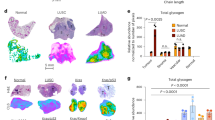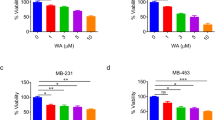Abstract
IT was found some years ago1 that dl-glyceric aldehyde inhibits glycolysis of tumour cells. Anærobic glycolysis is inhibited about 75 per cent by 10-3 M., whereas aerobic glycolysis is not affected by this concentration. Aerobically, it takes four times this amount to produce the same effect. Concentrations higher than 4 × 10-3 M. of the aldehyde are toxic.
This is a preview of subscription content, access via your institution
Access options
Subscribe to this journal
Receive 51 print issues and online access
$199.00 per year
only $3.90 per issue
Buy this article
- Purchase on SpringerLink
- Instant access to full article PDF
Prices may be subject to local taxes which are calculated during checkout
Similar content being viewed by others
References
Mendel, B., Klin. Woch., 8, 169 (1929).
Needham, J., and Lehmann, H., NATURE, 140, 198 (1937). Biochem. J., 31, 1210, 1913 (1937).
Author information
Authors and Affiliations
Rights and permissions
About this article
Cite this article
MENDEL, B., STRELITZ, F. & MUNDELL, D. d-Glyceric Aldehyde and Tumour Glycolysis. Nature 141, 288 (1938). https://doi.org/10.1038/141288a0
Issue date:
DOI: https://doi.org/10.1038/141288a0
This article is cited by
-
Mechanism of Glyceraldehyde Inhibition of Glycolysis
Nature (1950)



